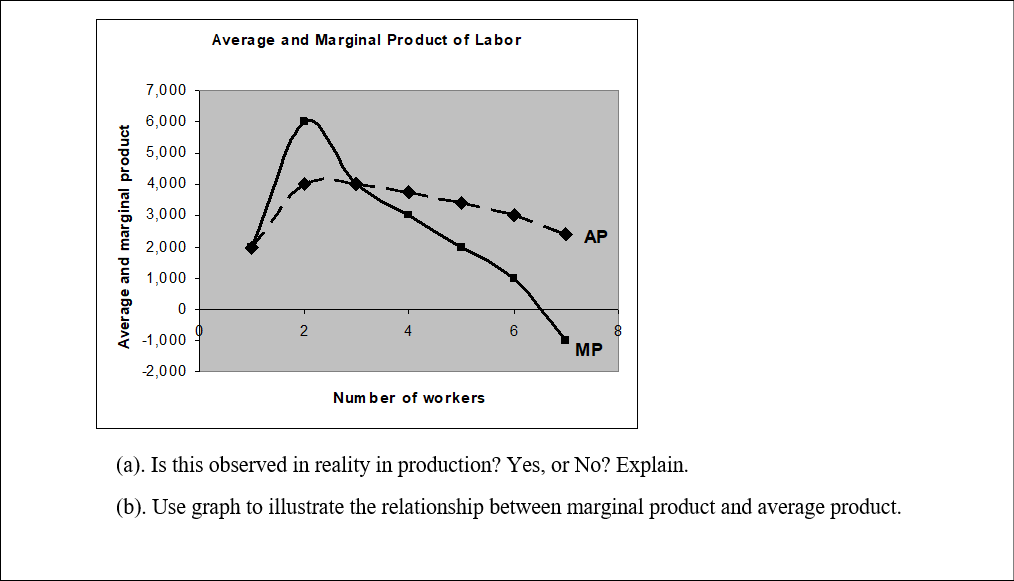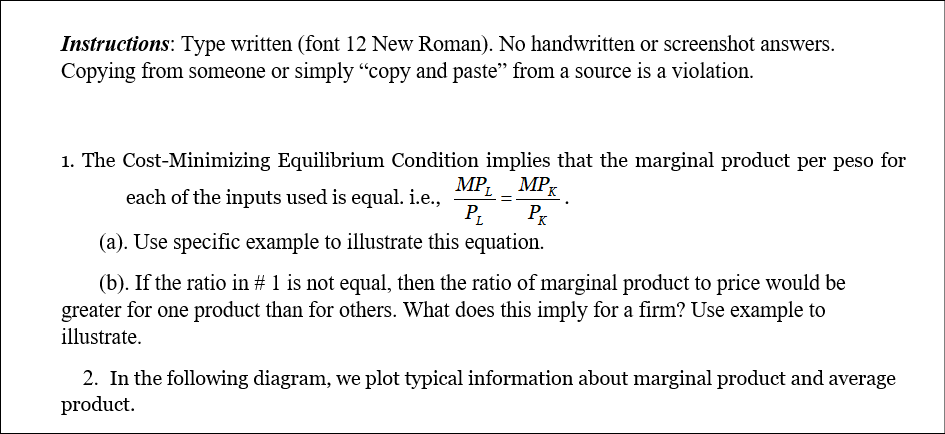Average and Marginal Product of Labor 7,000 6,000 5,000 4,000 3,000 AP 2,000 1,000 2 4 6 -1,000 MP -2,000 Num ber of workers (a). Is this observed in reality in production? Yes, or No? Explain. (b). Use graph to illustrate the relationship between marginal product and average product. Average and marginal product 00
Average and Marginal Product of Labor 7,000 6,000 5,000 4,000 3,000 AP 2,000 1,000 2 4 6 -1,000 MP -2,000 Num ber of workers (a). Is this observed in reality in production? Yes, or No? Explain. (b). Use graph to illustrate the relationship between marginal product and average product. Average and marginal product 00
Chapter1: Making Economics Decisions
Section: Chapter Questions
Problem 1QTC
Related questions
Question

Transcribed Image Text:Average and Marginal Product of Labor
7,000
6,000
5,000
4,000
3,000
AP
2,000
1,000
2
4
6.
8
-1,000
MP
-2,000
Num ber of workers
(a). Is this observed in reality in production? Yes, or No? Explain.
(b). Use graph to illustrate the relationship between marginal product and average product.
Average and marginal product

Transcribed Image Text:Instructions: Type written (font 12 New Roman). No handwritten or screenshot answers.
Copying from someone or simply “copy and paste" from a source is a violation.
1. The Cost-Minimizing Equilibrium Condition implies that the marginal product per peso for
MP. МP
each of the inputs used is equal. i.e.,
Px
(a). Use specific example to illustrate this equation.
(b). If the ratio in # 1 is not equal, then the ratio of marginal product to price would be
greater for one product than for others. What does this imply for a firm? Use example to
illustrate.
2. In the following diagram, we plot typical information about marginal product and average
product.
Expert Solution
This question has been solved!
Explore an expertly crafted, step-by-step solution for a thorough understanding of key concepts.
Step by step
Solved in 3 steps

Knowledge Booster
Learn more about
Need a deep-dive on the concept behind this application? Look no further. Learn more about this topic, economics and related others by exploring similar questions and additional content below.Recommended textbooks for you


Principles of Economics (12th Edition)
Economics
ISBN:
9780134078779
Author:
Karl E. Case, Ray C. Fair, Sharon E. Oster
Publisher:
PEARSON

Engineering Economy (17th Edition)
Economics
ISBN:
9780134870069
Author:
William G. Sullivan, Elin M. Wicks, C. Patrick Koelling
Publisher:
PEARSON


Principles of Economics (12th Edition)
Economics
ISBN:
9780134078779
Author:
Karl E. Case, Ray C. Fair, Sharon E. Oster
Publisher:
PEARSON

Engineering Economy (17th Edition)
Economics
ISBN:
9780134870069
Author:
William G. Sullivan, Elin M. Wicks, C. Patrick Koelling
Publisher:
PEARSON

Principles of Economics (MindTap Course List)
Economics
ISBN:
9781305585126
Author:
N. Gregory Mankiw
Publisher:
Cengage Learning

Managerial Economics: A Problem Solving Approach
Economics
ISBN:
9781337106665
Author:
Luke M. Froeb, Brian T. McCann, Michael R. Ward, Mike Shor
Publisher:
Cengage Learning

Managerial Economics & Business Strategy (Mcgraw-…
Economics
ISBN:
9781259290619
Author:
Michael Baye, Jeff Prince
Publisher:
McGraw-Hill Education